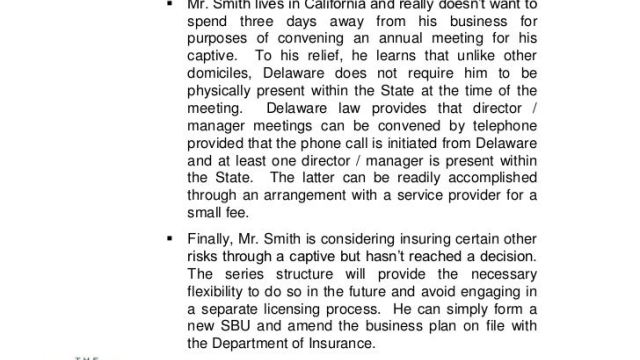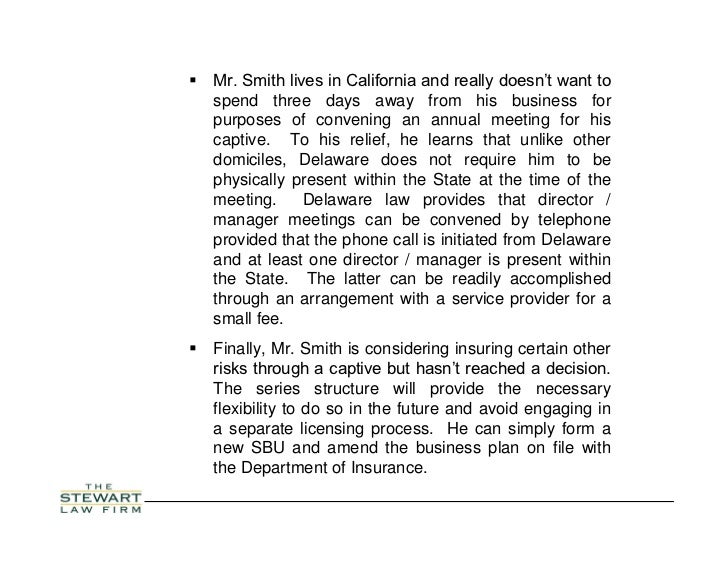
Unlocking the Benefits: Exploring Captive Insurance Strategies
Captive insurance has emerged as a powerful risk management tool for businesses of all sizes. In essence, it provides a means for companies to take control of their own insurance needs by forming their own insurance companies, or "captives." This approach allows businesses to tailor insurance coverage specifically to their unique risks and circumstances, thereby maximizing protection and cost-effectiveness.
One particular provision within the captive insurance realm that has gained attention is under the Internal Revenue Service (IRS) tax code section 831(b). This tax code identifies microcaptives or small captives with lower premiums and significant tax advantages. By electing under this provision, businesses can enjoy tax benefits, including the ability to exclude premiums from taxable income, ultimately creating potential tax savings. This has made captives under the IRS 831(b) tax code an attractive option for many.
In this article, we will delve deeper into the world of captive insurance and explore the benefits that businesses can unlock through the implementation of captive insurance strategies. We will examine the various aspects of captive insurance, including how it works, the advantages it offers, and the requirements to establish and maintain a successful captive program. So, let’s embark on this journey to unravel the potential of captive insurance and discover how it can be a game-changer for businesses in managing their risks efficiently.
Understanding Captive Insurance
Captive insurance is a unique strategy utilized by businesses to manage their risks in a more customized and cost-effective manner. This approach involves the creation of a wholly-owned subsidiary, commonly known as a "captive," which is formed specifically to provide insurance coverage to its parent company and affiliated entities.
A key advantage of captive insurance is that it allows businesses to tailor their insurance program according to their specific needs and risk profile. Unlike traditional insurance, where policies are purchased from third-party insurers with predetermined terms and conditions, captives provide more flexibility and control. By establishing their own insurance company, businesses can design policies that align with their unique risk exposures, ensuring adequate coverage while potentially reducing costs.
One notable aspect of captive insurance is the utilization of the Internal Revenue Code Section 831(b), commonly referred to as the IRS 831(b) tax code. Under this provision, small captives, also known as microcaptives, may elect to be taxed only on their investment income while enjoying certain tax advantages. This has made captive insurance an attractive option for many small to mid-sized enterprises seeking to better manage their insurance risks while benefiting from potential tax efficiencies.
In summary, captive insurance is a risk management strategy that involves the creation of a subsidiary insurance company to provide coverage to its parent company and affiliates. This approach offers businesses greater flexibility and control over their insurance programs, and when structured properly, may provide tax advantages under the IRS 831(b) tax code. Captive insurance can be a valuable tool for businesses looking to unlock the benefits of a more tailored and cost-effective insurance solution.
###Leveraging IRS 831(b) Tax Code
Captive insurance is a powerful strategy that allows businesses to take control of their insurance needs and potentially unlock various financial benefits. One key aspect of captive insurance is the utilization of the IRS 831(b) tax code, which provides certain advantages for qualifying micro-captives.
By harnessing the potential of the IRS 831(b) tax code, businesses can find new opportunities to manage their risks effectively and enhance their financial stability. Under this code, qualifying captives with annual premiums below $2.3 million can elect to be taxed only on their investment income, rather than on their total premium income. This tax advantage can lead to significant cost savings for businesses, positioning them for long-term success.
The IRS 831(b) tax code presents a unique opportunity for small- to medium-sized enterprises to enhance their risk management capabilities while optimizing their tax position. By establishing a micro-captive and electing to be taxed under this code, businesses can retain more of their premium income instead of paying it out to traditional insurance providers. This retained income can then be reinvested into the business, further fueling growth and resilience.

However, it’s essential to note that while the IRS 831(b) tax code offers great benefits, it must be approached with prudence and adherence to regulatory guidelines. Proper compliance and governance measures are crucial in establishing and maintaining a legitimate captive insurance structure. A comprehensive understanding of the tax code and engaging with experienced professionals in the field can help businesses navigate the complexities and unlock the full potential of captive insurance strategies.
In conclusion, the IRS 831(b) tax code serves as a valuable tool for businesses looking to leverage captive insurance strategies. The tax advantages it offers can not only optimize their risk management practices but also provide significant financial benefits. As businesses explore the potential of captive insurance, understanding and harnessing the advantages provided by the IRS 831(b) tax code can pave the way for a more secure and prosperous future.
Exploring Microcaptive Insurance
Irs 831b Tax Code
In the world of captive insurance, one specific strategy that has gained significant attention is microcaptive insurance. This approach is closely connected to the IRS 831(b) tax code, which offers certain advantages to small insurance companies.
Microcaptive insurance involves the establishment of a small insurance company, or "microcaptive," where the insured risks are often related to the parent company or a group of related entities. This strategy allows these companies to effectively manage their risks while benefiting from potential tax advantages.
By utilizing the IRS 831(b) tax code, microcaptives can qualify for certain tax exemptions on their premium income. This provision enables these small insurance companies to retain a portion of the premiums they collect as tax-free income, effectively reducing their overall tax liability.
However, it is important to note that the IRS has been closely scrutinizing microcaptive transactions in recent years. The agency has expressed concerns about potential abuse of this strategy for tax avoidance purposes. Therefore, it is crucial for companies engaging in microcaptive insurance to ensure compliance with all applicable regulations and guidelines.
In conclusion, microcaptive insurance provides smaller companies with the opportunity to establish their own insurance company and enjoy potential tax benefits. Nevertheless, it is essential for businesses considering this strategy to seek professional advice and stay updated on any regulatory developments to ensure they are utilizing microcaptive insurance in a compliant and responsible manner.

